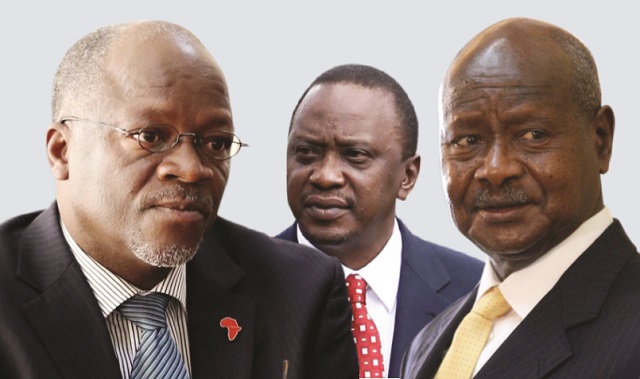
Behind Museveni, Kenyatta, Magufuli moves in US$ 3.5bn deal
In what has become a tension and release pattern, the plan to construct Africa’s longest heated oil pipeline from Uganda to the Indian Ocean coast hit a milestone with the signing on May 26 of a construction agreement deal between Uganda and Tanzania. But the signing brought new tension over the deal – this time regarding its financing.
The 1,445 km long pipeline is being billed as a major piece of regional integration infrastructure but behind the scenes activity around the deal reveal an aggressive bid by each country to gain advantage.
On one hand, President Yoweri Museveni and his teams in the Ministry of Energy is playing political poker with counterparts; President Uhuru Kenyatta of Kenya and John Pombe Magufuli of Tanzania and their teams.
On the other hand are the three oil companies; the China National Offshore Oil Corporation, Total E&P, the local subsidiary of the French oil giant Total SA, and Tullow Oil Uganda, a subsidiary of the Irish oil explorer. Behind these and readying to do the actual work were the Texas-based firm Gulf Interstate Engineering (GIE), China Communications Construction Company (CCCC), and the Toyota Tsusho Corporation (TTC) of Japan.
The jostling over the construction deal has been intense because, although Uganda is the sponsor of the pipeline, Kenya, Tanzania, USA, Japan, and China stood to greatly benefit both from the project implementation phase and in long-term oil business accruals. In the end Tanzania and Total won the deal as Kenya the Japanese appeared to have gotten entangled in their own strategy. But The Independent has also been told that Tanzania almost lost out as its attempt to squeeze the most out of Uganda nearly pushed the deal to Kenya.
Kenya’s mistake
Initially, when in August 2015 Presidents Museveni and Kenyatta signed the first MoU, Kenya appeared poised to take the deal. But Kenya appears to have been blinded by its biggest attraction; the offer of a shorter route than Tanzania.
The length of pipeline is critical because it has to be a heated pipeline to carry Uganda’s oil which is heavy, waxy, and quick to solidify at room temperature.
As such, the pipeline has to be heated and kept at above 50 degrees Celsius for the crude to flow from Hoima in mid-western Uganda to Tanga port.
This explains why the 1445 km long pipeline will have 48 independent power generation stations, 23 trace heating stations and six pumping stations. During its construction, there will be 11 construction camps. It will also have 53 block valve stations (for connections along water bodies) and five tanks of 500,000 barrels at Tanga.
Based on the assumption that it had the shorter route, Kenya decided to rope in its other ambitious infrastructure project; the Lamu Port-South Sudan-Ethiopia-Transport (LAPPSET) corridor.
Kenya has been trying to get off the ground its beastly infrastructure project, the LAPSSET, which aims to link East Africa’s biggest economy to South Sudan, Ethiopia and Uganda and starts with a port at Lamu. This, observers say, is what pushed Kenya to discourage Uganda from contemplating a pipeline along the existing Mombasa-Nairobi- Eldoret refined petroleum pipeline.
Kenyan officials also reportedly wanted the Lamu route because of a speculative motive as they have invested heavily in the LAPSSET corridor and hopped to benefit. Politicians had promised to develop northern Kenya with LAPSETT infrastructure. They, therefore, made presentations showing the disadvantages of the Mombasa route. One such disadvantage was that the pipeline would have to go through a national park and Nairobi and would attract costly litigations and compensations.
With Mombasa knocked out, the contest remained between Lamu and Tanga. Kenya had also managed to get CNOOC to join Tullow in lobbying for the Lamu route. Tullow already has oil in Turkana so if the pipeline went through Kenya, it would benefit from economies of scale.
 The Independent Uganda: You get the Truth we Pay the Price
The Independent Uganda: You get the Truth we Pay the Price




Let the hostee dream big like kenyatta with great